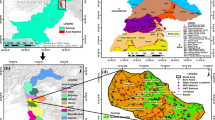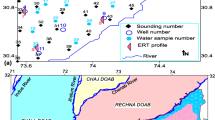Abstract
This article is aimed to delineate groundwater sources in Holocene deposits area in the Gulf of Mannar Coast from Southern India. For this purpose 2-D electrical resistivity tomography (ERT), hydrochemical and granulomerical studies were carried out and integrated to identify hydrogeological structures and portable groundwater resource in shallow depths which in general appears in the coastal tracts. The 2-D ERT was used to determine the two-dimensional subsurface geological formations by multi-core cable with Wenner array. Low resistivity of 1–5 Ω m for saline water appeared due to calcite at the depth of about 5 m below the ground level (bgl). Sea water intrusion was observed around the maximum resistivity as 5 Ω m at the 8 m depth, bgl in the calcite environs, but the calcareous sandstone layer shows around 15–64 Ω m at the 6 m depth, bgl. The hydrochemical variation of TDS, HCO3 −, Cl−, Na+, K+, Ca2+, and Mg2+ concentrations was observed for the saline and sea water intrusion in the groundwater system. The granulometic analysis shows that the study area was under the sea between 5400 and 3000 year ago. The events of ice melting an unnatural ice-stone rain/hail among 5000–4000 years ago resulted in the inundation of sea over the area and deposits of late Holocene marine transgression formation up to Puthukottai quartzite region for a stretch of around 17 km.













Similar content being viewed by others
References
Aguilar JR (2013) Analysis of grain size distribution and hydraulic conductivity for a variety of sediment types with application to Wadi Sediments. Thesis for Master degree, King Abdullah University of Science and Technology, Thuwal, Kingdom of Saudi Arabia, p 134
American Public Health Association (APHA) (1985) Standard methods for the examination of water & waste. 16th edn. Am Public Health Assoc Washington DC, p 100
Angusamy NG, Rajamanickam V (2007) Coastal processes of Central Tamil Nadu, India: clues from grain size studies. Oceanologia 49(1):41–57
Antony Ravindran A, Ramanujam N (2014) Detection of submarine groundwater discharge to coastal zone study using 2-D electrical resistivity imaging study at Manapad, Tuticorin, India. Indian J Geo Mar Sci 43(2):224–228
Arshad M, Shakoor A, Ahmad I, Ahmad M (2013) Hydraulic transmissivity determination for the groundwater exploration using vertical electrical sounding method in comparison to the traditional methods. Pak J Agri Sci 50(3):487–492
Chik Z, Islam SMT (2012) Finding soil particle size through electrical resistivity in soil site investigations. Electro J Geotech Eng 17:1867–1876
Choudhury K, Saha DK, Chakraborty P (2001) Geophysical study for saline water intrusion in a coastal alluvial terrain. J Geophys 46:189–200
Dahlin T, Loke M (1998) Resolution of 2D Wenner resistivity imaging as assessed by numerical modelling. J Appl Geophys 38:237–249
Domenico PA, Schwartz FW (1990) Physical and chemical hydrogeology. Wiley, New York
Edet AE, Okereke CS (2002) Delineation of shallow groundwater aquifers in the coastal plain sands of Calabar area (Southern Nigeria) using surface resistivity and hydrogeological data. J Afr Earth Sci 35(3):433–443
Folk RL (1974) Petrology of sedimentary rocks. Hemphili Publication, Company, Austin, p 182
Friedman GM (1961) Distinction between dune, beach and river sands from their textural Characteristics. J Sediment Petrol 31(4):514–529
Frohlich RK, Urish DW, Fuller J, Reilley MO (1994) Use of geoelectrical method in groundwater pollution surveys in a coastal environment. J Appl Geophys 32:139–154
Griffth DH, Turnbull J (1985) A multi-electrode array for resistivity surveying. First Break 3:16–20
Gurunadha Rao VVS, Tamma Rao G, Surinaidu L, Rajesh R, Mahesh J (2011) Geophysical and geochemical approach for sea water intrusion assessment in the Godavari Delta Basin, A.P., India. Water Air Soil Pollut 217(1–4): 503–514
Joshua EO, Oyebanjo OA (2010) Grain-size and heavy mineral analysis of river Osun sediments sandstones. J Geol 70:737–753
Koike K, Matsuda S (2005) Spatial modeling of discontinuous geologic attributes with geotechnical applications. Eng Geol 78:143–161
Krishna Kumar S, Chandrasekar N, Seralathan P, Dajkumar Sahayam J (2012) Diagenesis of Holocene reef and associated beach rock of certain coral islands, Gulf of Mannar, India: implication on climate and sea level. J Earth Syst Sci 121(3):733–745
Loke M, Acworth I, Dahlin T (2003) A comparison of smooth and blocky inversion methods in 2-D electrical imaging surveys. Expl Geophys 34:182–187
Mazac O, Kelly WE, Landa I (1985) A hydrogeophysical model for relations between electrical and hydraulic properties of aquifers. J Hydrol 79:1–19
Melloul A, Collin M (2006) Hydrogeological changes in coastal aquifers due to sea level rise. Ocean Coast Manage 49:281–297
Meybeck M (1979) Concentrations des eaux fluviales en elements majeurs et apports en solution aux oceans. Rev Geol Dyn Geogr Phys 21:215–246
Misonou T, Asaue H, Yoshinaga T, Matsukuma Y, Koike K, Shimada J (2013) Hydrogeologic-structure and groundwater-movement imaging in tideland using electrical sounding resistivity: a case study on the Ariake Sea coast, southwest Japan. Hydrogeol J 21:1593–1603
Mondal NC, Rao VA, Singh VS, Sarwade DV (2008) Delineation of concealed lineaments using electrical resistivity imaging in granitic terrain. Curr Sci 94(8):1023–1030
Mondal NC, Singh VS, Rangarajan R (2009) Aquifer characteristics and its modeling around an industrial complex, Tuticorin, Tamil Nadu, India: a case study. J Earth Sys Sci 188(3):231–244
Mondal NC, Singh VP, Singh VS, Saxena VK (2010) Determining the interaction between groundwater and saline water through groundwater major ions chemistry. J Hydrol 388(1–2):100–111
Mondal NC, Singh VP, Singh S, Singh VS (2011) Hydrochemical characteristic of coastal aquifer from Tuticorin, Tamil Nadu, India. Environ Monit Assess 175(1–4):531–550
Pozdnyakova L, Pozdnyakov A, Zhang R (2001) Application of geophysical methods to evaluate hydrology and soil properties in urban areas. Urban Water 3:205–216
Rangarajan R, Mondal NC, Singh VS, Singh SV (2009) Estimation of natural recharge and its relation with aquifer parameters in and around Tuticorin town, Tamil Nadu, India. Curr Sci 97(2):217–226
Revelle R (1941) Criteria for recognizing sea water in groundwater. Am Geophys Union Trans 22:593–597
Sankaran S, Sonkamble S, Krishnakumar K, Mondal NC (2012) Integrated approach for demarcating subsurface pollution and saline water intrusion zones in SIPCOT area: a case study from Cuddalore in Southern India. Environ Monitor Assess 184(8):5121–5138
Sarma VVJ, Prasad NVBSS, Prasad R (1982) The geochemistry of groundwater along Visakhatnam–Bhimilipatnam coast with regard to their utility in drinking, domestic and irrigation purposes. J Expl Geophys 2(4):37–52
Sarwade DV, Nandakumar MV, Kesari MP, Mondal NC, Singh VS, Singh B (2007) Evaluation of sea water ingress into an Indian Attoll. Environ Geol 52(2):1475–1483
Saxena VK, Singh VS, Mondal NC, Jain SC (2003) Use of chemical parameters to delineation fresh groundwater resources in Potharlanka Island, India. Environ Geol 44(5):516–521
Selvam S, Manimaran G, Sivasubramanian P, Balasubramanian N, Seshunarayana T (2014) GIS-based evaluation of water quality index of groundwater resources around Tuticorin coastal city South India Environ. Earth Sci 71:2847–2867
Singa Raja V, Shah BM (2006) Holocene marine transgression in the Eleru Delta, East Godavari District, Andhra Pradesh. J Geol Soc India 67:605–608
Stoddart DR, Gopinatha Pillai CS (1972) Raised reefs of Ramanathapuram, South India. Trans. Inst of British Geographers. Pub., No. 56
Swamy ASR (2012) Sedimentary environments in the Godavari delta. In: ONGC Academy Sponsored Training Programme on “Modern Deltas—a Field Seminar” Organized by Delta Studies Institute, Andhra University, Visakhapatnam, 3–7 December, 2012, pp 165–175
Turekian KK (1977) Geochemical distribution of elements, 4th edn. Encyclopedia of Science and Technology, McGraw-Hill, New York, p 630
Valentina YH, Petra JM, Sergey K, Evgeny L (2013) Holocene marine transgression in the Black Sea: new evidence from the northwestern Black Sea shelf. Quatern Int. doi:10.1016/j.quaint.2013.07.027
Wilson SR, Ingham M, McConchie JA (2006) The applicability of earth resistivity methods for saline interface definition. J Hydrol 316:301–312
World Health Organization (WHO) (1984) Guideline of drinking quality. World Health Organization, Washington, DC, pp 333–335
Acknowledgments
First author expresses his sincere thanks to Mr. A.P.C.V. Chockalingam, Secretary and Principal of V.O.C. College, Thoothukudi, Tamil Nadu. The helps extended by Professors and Head, Department of Geology, V.O. Chidambaram College, Thoothukudi. The anonymous reviewers have suggested their constructive comments to improve the article. The authors are thankful to them.
Author information
Authors and Affiliations
Corresponding author
Rights and permissions
About this article
Cite this article
Antony Ravindran, A., Mondal, N.C., Ramanujam, N. et al. Appraisal of groundwater resource in Holocene soil deposits by resistivity, hydrochemical and granulomerial studies in the Gulf of Mannar Coast from Southern India. Environ Earth Sci 75, 166 (2016). https://doi.org/10.1007/s12665-015-4883-8
Received:
Accepted:
Published:
DOI: https://doi.org/10.1007/s12665-015-4883-8




